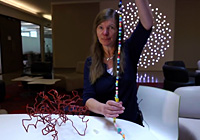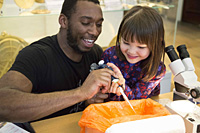Biochemistry researchers at the University of Oxford share their work with the public in crystallography's centenary year
 X-ray crystallography has never had so prominent a place in the world. The illustrious history of the field and its discoveries were celebrated by numerous events across the UK and elsewhere during 2014, the International Year of Crystallography, www.iycr2014.org. Researchers from the Department of Biochemistry at the University of Oxford participated in several of these events.
X-ray crystallography has never had so prominent a place in the world. The illustrious history of the field and its discoveries were celebrated by numerous events across the UK and elsewhere during 2014, the International Year of Crystallography, www.iycr2014.org. Researchers from the Department of Biochemistry at the University of Oxford participated in several of these events.
Jointly organised by the IUCr and UNESCO, the year commemorated the centennial of the birth of X-ray crystallography, thanks to the work of Max von Laue and the Braggs father and son.
The award of the Nobel Prize to Max von Laue in 1914 recognised his work on copper sulphate crystals. He was the first person to discover that X-rays can be diffracted by crystals and observed the characteristic spots from these crystals.
Taking the work a step further, William and Lawrence Bragg discovered that X-rays could be used to determine the positions of atoms within crystals accurately. By formulating "Bragg’s Law", they gave researchers the tool to interpret the diffraction pattern of spots and generate a detailed picture of the three-dimensional structure of compounds. They received a Nobel Prize for this achievement in 1915.
The International Year of Crystallography aimed to mark these and many other milestones in the field, from the discovery of the DNA double helix to groundbreaking work on graphene and the ribosome complex (around 280,000 non-hydrogen atoms). Through an incredible variety of activities including science fairs, exhibitions and professional-level training sessions, crystallography has been brought to life for many different audiences.
Several crystallography researchers from the Biochemistry department contributed to events marking a century of crystallography; these included Professor Elspeth Garman; Jonny Brooks-Bartlett, a DPhil student in Elspeth's group; Associate Professor Matt Higgins; Professor Judy Armitage and Professor Mark Sansom.
century of crystallography; these included Professor Elspeth Garman; Jonny Brooks-Bartlett, a DPhil student in Elspeth's group; Associate Professor Matt Higgins; Professor Judy Armitage and Professor Mark Sansom.
Talking to a reporter Professor Garman comments, "The year has really raised the profile of the topic internationally and has resulted in lots of outreach and public engagement activities. There is a new energy and it has really benefited countries where there are limited activities in the field. Some of the initiatives will undoubtedly be continued".
This press release is reprinted from material taken from the Department of Biochemistry website at the University of Oxford. The link to the original press release can be found here.

